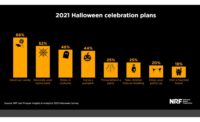Pre-Halloween candy buying up this year: Numerator
YTD seasonal candy sales up 29 percent versus a year ago.

Numerator says the pre-Halloween candy buying period is capturing more consumers this year.
The company has launched a Candy Tracker to monitor omnichannel sales trends, promotional activity, and advertising for both seasonal and non-seasonal candy. Overall, the candy category is up versus 2020 and pre-pandemic 2019.
Seasonal candy
- Sales of seasonal candy are up 29 percent to-date in the second half of 2021 versus year-ago, and up 43 percent versus two years ago.
- Growth is primarily driven by an increase in household penetration in the category (+4.5 points versus 2020, +5.9 points versus 2019), though household buying rates are also elevated compared to previous years.
- Overall trips made for seasonal candy are up as well (+19 percent versus year-ago, +30 percent versus two years ago).
Non-seasonal candy
Everyday candy continues to be a regular purchase for the majority of consumers:
- Sales of non-seasonal candy (which make up the bulk of overall candy sales through the year) are up 19 percent versus 2020 and up 24 percent versus 2019.
- Growth is driven by higher buy rates per household (+$7.54 versus 2020, +$9.59 versus 2019), and a small increase in overall household penetration.
- In 2020, non-seasonal candy saw a pronounced boost the week of Halloween, as consumers supplemented traditional Halloween candy purchase with their everyday favorites.
- Trips for non-seasonal candy are also up (+12 percent versus year-ago, +13 percent versus two years ago)
Candy promotions and advertising
- Total promoted products within the seasonal candy category are up 47 percent July through September versus 2020, and up 36 percent versus 2019. Increases were most significant early in the season, with promoted products up more than 200 percent in July versus year-ago.
- Promotions for non-seasonal/everyday candy are also elevated to a lesser degree (+33 percent versus 2020, +21 percent versus 2019).
- Consumers are buying more candy despite decreased advertising. Candy related ad spend is down significantly (-29 percent versus 2020, -34 percent versus 2019), and candy related ad occurrences are down slightly (-5% versus 2020, -8% versus 2019)
Looking for a reprint of this article?
From high-res PDFs to custom plaques, order your copy today!









